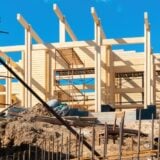The national foreclosure inventory fell by 33% year on year in August 2014 to approximately 629,000 properties, or 1.6% of all homes with a mortgage, down from 936,000, or 2.4% in August 2013.
According to the data from CoreLogic this marks 34 months of continuous year on year declines in the inventory of foreclosed homes, including 19 straight months of declines greater than 20%.
Also in August, the 12 month sum of completed foreclosures continued to decline, dropping 20% from a year ago to 576,000. The seriously delinquent inventory fell to 1.6 million loans, a 21.7% decline from August 2013.
The five states with the largest year on year drop in the foreclosure inventory were Utah which was down 46%, Idaho down 45.6%, Arizona down 44.5%, Florida down 43.6% and Iowa down 42.6.
The data also shows that 49 states posted declines in the foreclosure inventory from a year ago, with 44 states showing decreases of more than 20%. Only the District of Columbia and Wyoming saw year on year increases in foreclosure inventory.
Florida has seen the biggest improvement, falling 7.3% from its February 2011 peak level of 12.5% to its August rate of 5.2%. The foreclosure rate in New Jersey peaked in March 2013, much later than in Florida and the state has a 1.6% improvement in the foreclosure rate from its peak rate.
Both New York and Hawaii experienced peak foreclosure rates in September 2012, and have experienced similar declines in foreclosure rates, with New York falling 0.9% from its peak and Hawaii falling 1.1% from its peak.
Distressed sales (Real Estate Owned and short sales) accounted for 11.1% of total home sales in July 2014, the lowest share since December 2007 and a strong improvement from the same time a year ago when this category made up 15.5% of total sales.
Within this category, REO sales made up 7.1% of total home sales, and short sales made up 4% of total sales in July. At its peak, the distressed sales share totalled 32.5% of all sales in January 2009, with REO sales making up 28% of that share.
CoreLogic says in its report that the ongoing shift away from REO sales is a driver of improving home prices, as REOs typically sell at a larger discount than do short sales. There will always be some amount of distress in the housing market, so one would never expect a 0% distressed sales share, and by comparison, the pre-crisis share of distressed sales was traditionally about 2%.
Michigan had the largest share of distressed sales of any state at 26.3% in July, followed by Florida at 23.3%, Illinois at 23.3%, Nevada at 21.9% and Georgia at 19.8%. California experienced a 13.7% drop in the distressed sales share from a year earlier, the largest of any state. California also saw the largest improvement from peak distressed sales share of any state, falling 54.8% from the January 2009 peak share of 67.4%.
Of the largest 25 Core Based Statistical Areas (CBSAs) based on population, Chicago-Naperville-Arlington Heights in Illinois, had the largest share of distressed sales at 26.5% followed by Miami-Miami Beach-Kendall in Florida at 26.1%.
In Florida Orlando-Kissimmee-Sanford was at 24.5% and Tampa-St. Petersburg-Clearwater, at 24.4%. Las Vegas-Henderson-Paradise in Nevada was at 23.1%, while Sacramento-Roseville-Arden-Arcade in California had the largest drop in its distressed share from a year earlier, falling by 17.1% from 31.3% in July 2013 to 15.2% in July 2014.
Las Vegas-Henderson-Paradise in Nevada had the largest overall improvement in distressed sales share from its peak value. At the peak in April 2009, distressed sales made up 76.6% of all sales in Las Vegas compared to its July 2014 rate of 23.1%.





